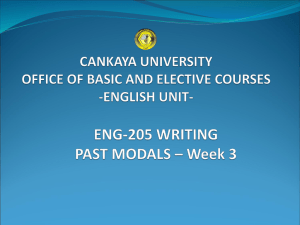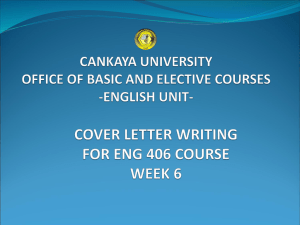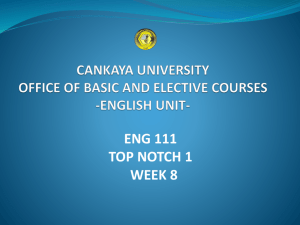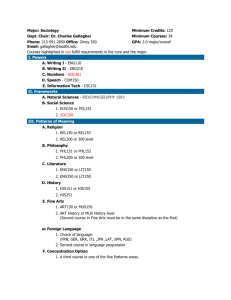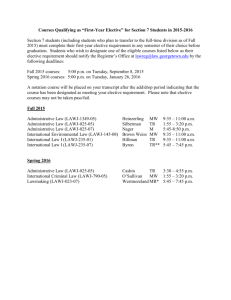COMPONENTS of A REPORT
advertisement
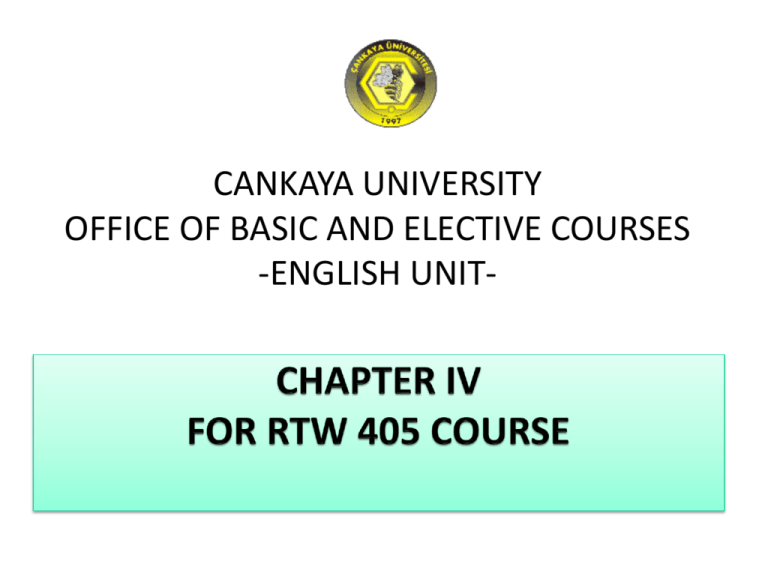
CANKAYA UNIVERSITY OFFICE OF BASIC AND ELECTIVE COURSES -ENGLISH UNIT- CHAPTER IV COMPONENTS of A REPORT OUTLINE 1. prefatory parts ( Front Matter) 2. body 3. supplementary parts (Back Matter) CANKAYA UNIVERSITY - OFFICE OF BASIC AND ELECTIVE COURSES- ENGLISH UNIT COMPONENTS of A REPORT Components of a report Formal (longer and more complex) reports are generally organized into three major divisions: prefatory parts ( Front Matter) body supplementary parts (Back Matter) CANKAYA UNIVERSITY - OFFICE OF BASIC AND ELECTIVE COURSES- ENGLISH UNIT COMPONENTS of A REPORT Components of a report Because reports are a genre widely used in the workplace, they have come to have standardized components. They include: Letter of transmittal Abstract Acknowledgements Title Page Table of Contents Executive Summary Glossary Appendices References or works cited CANKAYA UNIVERSITY - OFFICE OF BASIC AND ELECTIVE COURSES- ENGLISH UNIT COMPONENTS of A REPORT 1. PREFATORY PARTS PREFATORY PARTS (PRECEDING THE BODY OF REPORT) Preliminary pages (or prefatory parts) precede the text of the report, identfying the contents and giving credit to the people who created it. CANKAYA UNIVERSITY - OFFICE OF BASIC AND ELECTIVE COURSES- ENGLISH UNIT COMPONENTS of A REPORT 1. PREFATORY PARTS PREFATORY PARTS (PRECEDING THE BODY OF REPORT) Letter of Transmittal (or Memo of Transmittal) WHERE: Letter of transmittal or a cover letter is not a part of report itself but often accompanies it. It is attached as a separate piece of paper. Generally written on organization letterhead stationery, a letter or memo of transmittal introduces a formal report. primary purpose : to announce what the attached document is and what project it is related to. CANKAYA UNIVERSITY - OFFICE OF BASIC AND ELECTIVE COURSES- ENGLISH UNIT COMPONENTS of A REPORT 1. PREFATORY PARTS PREFATORY PARTS (PRECEDING THE BODY OF REPORT) Letter of Transmittal (or Memo of Transmittal) You use it primarily to orient your reader to the report’s purpose and topic. other purposes: selling the product or service by indicating that how the report is significant, preparing the reader for surprising and disappointing results. A transmittal letter or memo follows the direct pattern and is usually less formal than the report itself. For example, the letter or memo may use contractions and first-person pronouns such as me and us. CANKAYA UNIVERSITY - OFFICE OF BASIC AND ELECTIVE COURSES- ENGLISH UNIT COMPONENTS of A REPORT 1. PREFATORY PARTS PREFATORY PARTS (PRECEDING THE BODY OF REPORT) Letter of Transmittal (or Memo of Transmittal) The transmittal letter or memo typically : 1. announces the topic of the report and tells how it was authorized; 2. briefly describes the project; 3. highlights the report’s findings, conclusions, and recommendations, if the reader is expected to be supportive; 4. Closes with appreciation for the assignment, instructions for the reader’s follow-up actions, acknowledgment of help from others, or offers of assistance in answering questions. CANKAYA UNIVERSITY - OFFICE OF BASIC AND ELECTIVE COURSES- ENGLISH UNIT COMPONENTS of A REPORT 1. PREFATORY PARTS PREFATORY PARTS (PRECEDING THE BODY OF REPORT) Title Page Page at the front of a text that identifies the subject of a report and its recipient, author, and date. The title page identifies : the subject of the report its recipient, author, date. purpose : to identify the document. CANKAYA UNIVERSITY - OFFICE OF BASIC AND ELECTIVE COURSES- ENGLISH UNIT COMPONENTS of A REPORT 1. PREFATORY PARTS PREFATORY PARTS (PRECEDING THE BODY OF REPORT) Title Page Other information on the report depends on the needs of the reader. You can use it to provide other information, such as : a project number or grant number your telephone number and address. Thus, the title page may not only identify the report but make it easy for the readers to communicate with the writer. CANKAYA UNIVERSITY - OFFICE OF BASIC AND ELECTIVE COURSES- ENGLISH UNIT COMPONENTS of A REPORT 1. PREFATORY PARTS PREFATORY PARTS (PRECEDING THE BODY OF REPORT) Title Page A report title page begins with: 1. the name of the report typed in uppercase letters (no underscore and no quotation marks). 2. Next comes :Prepared for (or Submitted to) and the name, title, and organization of the individual receiving the report. 3. Lower on the page is Prepared by (or Submitted by) and the author’s name plus any necessary identification. T 4. The last item on the title page is the date of submission. All items after the title appear in a combination of upper- and lowercase letters. The information on the title page should be evenly spaced and balanced on the page for a professional look. CANKAYA UNIVERSITY - OFFICE OF BASIC AND ELECTIVE COURSES- ENGLISH UNIT COMPONENTS of A REPORT 1. PREFATORY PARTS PREFATORY PARTS (PRECEDING THE BODY OF REPORT) Title Page How To Write Titles *place the title about one-third from the top of the page followed by the name of the recipient, author, and date. *use a type size bigger than text size, perhaps 14-point type or larger. You should pay attention to two points about titles designed to help make a sharp impact on readers: should be short, preferably on one line only should specify exactly what the paper is talking about, not simply name a whole subject. CANKAYA UNIVERSITY - OFFICE OF BASIC AND ELECTIVE COURSES- ENGLISH UNIT COMPONENTS of A REPORT 1. PREFATORY PARTS PREFATORY PARTS (PRECEDING THE BODY OF REPORT) Title Page How To Write Titles EXAMPLE: Construction and instrumentation of an experimental concrete road on the trunk road D7 Upbridge bypass to determine the effect of omitting expansion joints. Effect of omitting expansion joints in concrete roads Construction and Instrumentation of an experiment on the D7 WHICH ONE IS MORE EFFECTIVE? CANKAYA UNIVERSITY - OFFICE OF BASIC AND ELECTIVE COURSES- ENGLISH UNIT COMPONENTS of A REPORT 1. PREFATORY PARTS PREFATORY PARTS (PRECEDING THE BODY OF REPORT) Title Page How To Write Titles Titles have two main purposes: 1. First, they have to inform readers about what is in the document. 2. Second, they have to distinguish one document from another. To achieve these goals, a report title gives two types of information: The topic The approach to the topic CANKAYA UNIVERSITY - OFFICE OF BASIC AND ELECTIVE COURSES- ENGLISH UNIT COMPONENTS of A REPORT 1. PREFATORY PARTS PREFATORY PARTS (PRECEDING THE BODY OF REPORT) Title Page How To Write Titles The topic defines the subject matter, such as radiation emitted from a computer monitor. The topic alone, however, does not demonstrate why and how you have considered the topic. You may have analyzed the feasibility of purchasing shields for monitors. Or you may have described the process of emission, or report the results of a scientific measurement. Consider the following title: The Effect of Electromagnetic Fields on Computer Users: A Review of Research Topic Approach The information orients the reader to the report topic and purpose, but it helps a reader to decide whether to read the report at all. Therefore, stating the approach clearly in the title is of great importance. CANKAYA UNIVERSITY - OFFICE OF BASIC AND ELECTIVE COURSES- ENGLISH UNIT COMPONENTS of A REPORT 1. PREFATORY PARTS PREFATORY PARTS (PRECEDING THE BODY OF REPORT) Abstract An abstract is a synopsis of the entire report brief enough to be read in only a few minutes. It provides an overview of the key elements of the report; enabling readers digest important information without having to read the report in its entirety. In fact, it helps the reader decide whether the report is worth reading. CANKAYA UNIVERSITY - OFFICE OF BASIC AND ELECTIVE COURSES- ENGLISH UNIT COMPONENTS of A REPORT 1. PREFATORY PARTS PREFATORY PARTS (PRECEDING THE BODY OF REPORT) Abstract There are 2 basic types of abstracts: indicative and informative. The indicative abstract indicates the kind of information included in the report. It’s a description rather than exposition. It outlines what is covered in the report but does not attempt to provide a lot of information . It usually includes these points: Purpose Method Conclusion Recommendation CANKAYA UNIVERSITY - OFFICE OF BASIC AND ELECTIVE COURSES- ENGLISH UNIT COMPONENTS of A REPORT 1. PREFATORY PARTS PREFATORY PARTS (PRECEDING THE BODY OF REPORT) Abstract There are 2 basic types of abstracts: indicative and informative. The informative abstract condenses the information in the report into a brief factual statement. It provides readers with sufficient information to render the reading of the entire document optional. It provides in condensed form all of the essential information in the report: Purpose Method Scope Key sections of the text ( findings, problems, possible solutions, etc) Conclusions Recommendations CANKAYA UNIVERSITY - OFFICE OF BASIC AND ELECTIVE COURSES- ENGLISH UNIT COMPONENTS of A REPORT 1. PREFATORY PARTS PREFATORY PARTS (PRECEDING THE BODY OF REPORT) Abstract Abstracts should be less than a single page long, single-spaced. They should be written in complete sentences with logical transitions. CANKAYA UNIVERSITY - OFFICE OF BASIC AND ELECTIVE COURSES- ENGLISH UNIT COMPONENTS of A REPORT 1. PREFATORY PARTS PREFATORY PARTS (PRECEDING THE BODY OF REPORT) Acknowledgements An acknowledgement is a statement of credit given to an individual or a group of individuals who have assisted the writer of the report. It names the person credited, the contributions s/he has made, and the effect of his/ her contribution. An acknowledgement is placed on a separate piece of paper and follows the abstract of the report. CANKAYA UNIVERSITY - OFFICE OF BASIC AND ELECTIVE COURSES- ENGLISH UNIT COMPONENTS of A REPORT 1. PREFATORY PARTS PREFATORY PARTS (PRECEDING THE BODY OF REPORT) Table of Contents The table of contents shows the headings in a report and their page numbers. The primary purpose :to let your readers find specific information easily. Its secondary purpose is to give your readers an overview of the content and structure of your report. You should wait to prepare the table of contents until after you have completed the report CANKAYA UNIVERSITY - OFFICE OF BASIC AND ELECTIVE COURSES- ENGLISH UNIT COMPONENTS of A REPORT 1. PREFATORY PARTS PREFATORY PARTS (PRECEDING THE BODY OF REPORT) Table of Contents It’s important to include an elaborative table of contents showing : main headings and all sub-headings, showing the relationship of those parts by indentation and a clear numbering system For short reports include all headings. For longer reports you might want to list only first- and second-level headings. Leaders (spaced or unspaced dots) help guide the eye from the heading to the page number. CANKAYA UNIVERSITY - OFFICE OF BASIC AND ELECTIVE COURSES- ENGLISH UNIT COMPONENTS of A REPORT 1. PREFATORY PARTS PREFATORY PARTS (PRECEDING THE BODY OF REPORT) Table of Contents The first item in the contents will most probably be the abstract or executive summary. Normally, you won’t list the preliminary pages unless you write a preface; however, you list the supplementary parts (or back matter), including the appendixes, references, and glossary. Do not mix table of contents with the” list of tables and figures”. The visuals are not parts of reports, so they are not included in table of contents page. CANKAYA UNIVERSITY - OFFICE OF BASIC AND ELECTIVE COURSES- ENGLISH UNIT COMPONENTS of A REPORT 1. PREFATORY PARTS PREFATORY PARTS (PRECEDING THE BODY OF REPORT) Table of Contents Suggestions For Writing Table of Contents Include sub-headings as well as main headings Write full and informative headings Use decimal numbering system, indentation, and varying weight of type CANKAYA UNIVERSITY - OFFICE OF BASIC AND ELECTIVE COURSES- ENGLISH UNIT COMPONENTS of A REPORT 1. PREFATORY PARTS PREFATORY PARTS (PRECEDING THE BODY OF REPORT) List of Tables and Figures You may list tables and figures (visual display of data) on a page following the contents page. This list is most useful when there are many visuals and your report is long. (The NISO standards require this list when there are five or more figures.) There is less need for this page in a 10-page report because readers can easily skim to locate the visuals. If you include the list, format it in the same way you formatted the table of contents page. Include: 1. The label and number ( Figure 1) 2. The title of the visual 3. The page number CANKAYA UNIVERSITY - OFFICE OF BASIC AND ELECTIVE COURSES- ENGLISH UNIT COMPONENTS of A REPORT 1. PREFATORY PARTS PREFATORY PARTS (PRECEDING THE BODY OF REPORT) Executive Summary An executive summary summarizes a long report, proposal, or business plan. It concentrates on what management needs to know from a longer report, so the purpose is to present an overview of a longer report to people who may not have time to read the entire document. This timesaving device summarizes; the purpose key points findings conclusions CANKAYA UNIVERSITY - OFFICE OF BASIC AND ELECTIVE COURSES- ENGLISH UNIT COMPONENTS of A REPORT 1. PREFATORY PARTS PREFATORY PARTS (PRECEDING THE BODY OF REPORT) Executive Summary An executive summary is usually no longer than 10 percent of the original document. Therefore, a 20-page report might require a 2-page executive summary. CANKAYA UNIVERSITY - OFFICE OF BASIC AND ELECTIVE COURSES- ENGLISH UNIT COMPONENTS of A REPORT 1. PREFATORY PARTS PREFATORY PARTS (PRECEDING THE BODY OF REPORT) Executive Summary General Guidelines: Present the goal or purpose of the document being summarized. Why was it written? Highlight the research methods (if appropriate), findings, conclusions, and recommendations. Omit illustrations, examples, and references. Organize for readability by including headings and bulleted or enumerated lists. Include your reactions or an overall evaluation of the document if asked to do so. CANKAYA UNIVERSITY - OFFICE OF BASIC AND ELECTIVE COURSES- ENGLISH UNIT COMPONENTS of A REPORT 2. BODY OF REPORT 2. BODY OF REPORT The main section of a report is the body. It generally begins with an introduction, includes a discussion of findings, and concludes with a summary and possibly recommendations. CANKAYA UNIVERSITY - OFFICE OF BASIC AND ELECTIVE COURSES- ENGLISH UNIT COMPONENTS of A REPORT 2. BODY OF REPORT 2. BODY OF REPORT All reports have a beginning that introduces the issue, a middle that presents the results of investigation, an ending that applies the results to the problem to show whether and how the problem is solved. CANKAYA UNIVERSITY - OFFICE OF BASIC AND ELECTIVE COURSES- ENGLISH UNIT COMPONENTS of A REPORT 2. BODY OF REPORT 2. BODY OF REPORT : Introduction The body of a formal report starts with an introduction that sets the scene and announces the subject. The introduction; Describes the problem or purpose that has occasioned the report. It answers the questions of : who, what, where, when, why how in order to establish the context for the problem and its significance. CANKAYA UNIVERSITY - OFFICE OF BASIC AND ELECTIVE COURSES- ENGLISH UNIT COMPONENTS of A REPORT 2. BODY OF REPORT 2. BODY OF REPORT Introduction It also forecasts the rest of the report by indicating how the report will develop and what its major sections are. A literature review may be a part of the introduction as a way of establishing the problem. CANKAYA UNIVERSITY - OFFICE OF BASIC AND ELECTIVE COURSES- ENGLISH UNIT COMPONENTS of A REPORT 2. BODY OF REPORT 2. BODY OF REPORT Introduction A good report introduction typically covers the following elements: Background Problem or purpose Significance Scope Sources and methods Summary Organization CANKAYA UNIVERSITY - OFFICE OF BASIC AND ELECTIVE COURSES- ENGLISH UNIT COMPONENTS of A REPORT 2. BODY OF REPORT 2. BODY OF REPORT Introduction A good report introduction typically covers the following elements, although not necessarily in this order: 1. 2. 3. Background: Describe the events leading up to the problem or need. Problem or purpose: Explain the report topic and specify the problem or need that motivated the report. Significance: Tell why the topic is important. You may wish to quote experts or cite secondary sources to establish the importance of the topic. CANKAYA UNIVERSITY - OFFICE OF BASIC AND ELECTIVE COURSES- ENGLISH UNIT COMPONENTS of A REPORT 2. BODY OF REPORT 2. BODY OF REPORT Introduction 4. 5. 6. 7. Scope. Clarify the boundaries of the report, defining what will be included or excluded. Sources and methods: Describe your secondary sources. Also explain how you collected primary data. Summary: Include a summary of findings, if the report is written directly. Organization: Preview the major sections of the report to follow, thus providing coherence and transition for the reader. CANKAYA UNIVERSITY - OFFICE OF BASIC AND ELECTIVE COURSES- ENGLISH UNIT COMPONENTS of A REPORT 2. BODY OF REPORT 2. BODY OF REPORT Discussion of Findings This is the main section of the report and contains numerous headings and subheadings. This section discusses, analyzes, interprets, and evaluates the research findings or solution to the initial problem. This is where you show the evidence that justifies your conclusions.. CANKAYA UNIVERSITY - OFFICE OF BASIC AND ELECTIVE COURSES- ENGLISH UNIT COMPONENTS of A REPORT 2. BODY OF REPORT 2. BODY OF REPORT Discussion of Findings It is unnecessary to use the title Discussion of Findings; many business report writers prefer to begin immediately with the major headings into which the body of the report is divided. You may organize the findings chronologically, geographically, topically, or by some other method. CANKAYA UNIVERSITY - OFFICE OF BASIC AND ELECTIVE COURSES- ENGLISH UNIT COMPONENTS of A REPORT 2. BODY OF REPORT 2. BODY OF REPORT Discussion of Findings •Regardless of the organizational pattern, present your findings logically and objectively. •In most cases you will want to avoid the use of first-person pronouns (I, we), unless you are certain that your audience prefers informal language. CANKAYA UNIVERSITY - OFFICE OF BASIC AND ELECTIVE COURSES- ENGLISH UNIT COMPONENTS of A REPORT 2. BODY OF REPORT 2. BODY OF REPORT Discussion of Findings Include tables, charts, and graphs if necessary to illustrate findings. Analytic and scientific reports may include another section titled Implications of Findings, in which the findings are analyzed and related to the problem. Less formal reports contain the author’s analysis of the research findings within the Discussion section. CANKAYA UNIVERSITY - OFFICE OF BASIC AND ELECTIVE COURSES- ENGLISH UNIT COMPONENTS of A REPORT 2. BODY OF REPORT 2. BODY OF REPORT Summary A summary review the main points of the report. If the report has been largely informational, it ends with a summary of the data presented. The report may end with a summary if the purpose of the report has been to describe an existing situation or the current state of knowledge. The summary thus wraps up the report and reinforces the main points. CANKAYA UNIVERSITY - OFFICE OF BASIC AND ELECTIVE COURSES- ENGLISH UNIT COMPONENTS of A REPORT 2. BODY OF REPORT 2. BODY OF REPORT Summary The summary also can prepare the readers for your conclusions and recommendations. A review of the main points can be especially useful in a long report that asks readers to recall a lot of information. CANKAYA UNIVERSITY - OFFICE OF BASIC AND ELECTIVE COURSES- ENGLISH UNIT COMPONENTS of A REPORT 2. BODY OF REPORT 2. BODY OF REPORT Conclusions The conclusion to a report tells what the findings mean, particularly in terms of solving the original problem. Conclusions answer the research question. If the report analyzes research findings, then it ends with conclusions drawn from the analyses. CANKAYA UNIVERSITY - OFFICE OF BASIC AND ELECTIVE COURSES- ENGLISH UNIT COMPONENTS of A REPORT 2. BODY OF REPORT 2. BODY OF REPORT Conclusions An analytic report frequently poses research questions. The conclusion to such a report reviews the major findings and answers the research questions. Conclusions go a step beyond summary because answering the questions requires evaluation and interpretation, including the reconciling of contradictory results. In a complex project, there may be multiple conclusions to draw and thus the section name is plural. CANKAYA UNIVERSITY - OFFICE OF BASIC AND ELECTIVE COURSES- ENGLISH UNIT COMPONENTS of A REPORT 2. BODY OF REPORT 2. BODY OF REPORT Recommendations This section directs the action. It advises what should be done based on the conclusions. If a report seeks to determine a course of action, it may end with conclusions and recommendations. Recommendations regarding a course of action may be placed in a separate section or incorporated with the conclusions. CANKAYA UNIVERSITY - OFFICE OF BASIC AND ELECTIVE COURSES- ENGLISH UNIT COMPONENTS of A REPORT 2. BODY OF REPORT 2. BODY OF REPORT Recommendations Managerial reports usually contain recommendations. The recommendations part do not need to provide much explanation because that has already been appeared in conclusions. CANKAYA UNIVERSITY - OFFICE OF BASIC AND ELECTIVE COURSES- ENGLISH UNIT COMPONENTS of A REPORT 2. BODY OF REPORT Creating Effective Visuals 1. Tables a. Formal Tables They give detailed information and include detailed heading system. Look at page 204. They include the following items: Table Number Title Units of measure Row Headings / Column Headings Data Footnotes Source CANKAYA UNIVERSITY - OFFICE OF BASIC AND ELECTIVE COURSES- ENGLISH UNIT COMPONENTS of A REPORT 2. BODY OF REPORT CANKAYA UNIVERSITY - OFFICE OF BASIC AND ELECTIVE COURSES- ENGLISH UNIT COMPONENTS of A REPORT 2. BODY OF REPORT Creating Effective Visuals 1. Tables b. Tables with text Compared with paragraphs, tables can present many kinds of textual information; thus, it is easier for the reader to understand. See sample on p.205. CANKAYA UNIVERSITY - OFFICE OF BASIC AND ELECTIVE COURSES- ENGLISH UNIT COMPONENTS of A REPORT 2. BODY OF REPORT 1. Tables b. Tables with text See sample on p.205. CANKAYA UNIVERSITY - OFFICE OF BASIC AND ELECTIVE COURSES- ENGLISH UNIT COMPONENTS of A REPORT 2. BODY OF REPORT Creating Effective Visuals Tips for creating tables: *Use extra space or horizontal lines to seperate the rows *Make key info stand out with bold, color, highlighting *Sort row and column headings (group related items under a common heading) * Avoid too large tables ( include only necesary info / if still large, divide it into 2 or more seperate parts. See sample on p.205. CANKAYA UNIVERSITY - OFFICE OF BASIC AND ELECTIVE COURSES- ENGLISH UNIT COMPONENTS of A REPORT 2. BODY OF REPORT Creating Effective Visuals 2. Line Graph (p.206) Use: 1. to show trends and cycles 2. To show the relationship between 2 or more variables. Key concepts: Figure Number Title Source Axis : X- axis & Y-axis Data Points CANKAYA UNIVERSITY - OFFICE OF BASIC AND ELECTIVE COURSES- ENGLISH UNIT COMPONENTS of A REPORT 2. BODY OF REPORT Creating Effective Visuals 2. Line Graph CANKAYA UNIVERSITY - OFFICE OF BASIC AND ELECTIVE COURSES- ENGLISH UNIT COMPONENTS of A REPORT 2. BODY OF REPORT Creating Effective Visuals 2. Line Graph CANKAYA UNIVERSITY - OFFICE OF BASIC AND ELECTIVE COURSES- ENGLISH UNIT COMPONENTS of A REPORT 2. BODY OF REPORT Creating Effective Visuals Tips for Creating Line Graphs • Use different colors to enable the readers distinguish among the lines. If you cannot use colors, use different dashes for each. • If possible begin lines at zero to avoid misleading readers. • If it’s not practical to start the lines at zero, use hash marks to signal this. CANKAYA UNIVERSITY - OFFICE OF BASIC AND ELECTIVE COURSES- ENGLISH UNIT COMPONENTS of A REPORT 2. BODY OF REPORT Creating Effective Visuals 3. Bar graphs (p.208) Use: to help your readers compare quantities and see the trends at a glance Key concepts: Figure Number Title Source Axis : Y-axis Labels for bars ***Arrange bars in the order that your readers will find most helpful. Alternatives include arranging them alphabetically, chronologically, or from longest to shortest CANKAYA UNIVERSITY - OFFICE OF BASIC AND ELECTIVE COURSES- ENGLISH UNIT COMPONENTS of A REPORT 2. BODY OF REPORT CANKAYA UNIVERSITY - OFFICE OF BASIC AND ELECTIVE COURSES- ENGLISH UNIT COMPONENTS of A REPORT 2. BODY OF REPORT CANKAYA UNIVERSITY - OFFICE OF BASIC AND ELECTIVE COURSES- ENGLISH UNIT COMPONENTS of A REPORT 2. BODY OF REPORT Creating Effective Visuals 4. Pie Charts (p.212) Use: to show the composition of a whole Key concepts: Figure Number Figure Title Wedges ***You can emphasize a particular wedge in 2 ways : 1 . Use contrasting color 2. pull a wedge out of the pie CANKAYA UNIVERSITY - OFFICE OF BASIC AND ELECTIVE COURSES- ENGLISH UNIT COMPONENTS of A REPORT 2. BODY OF REPORT CANKAYA UNIVERSITY - OFFICE OF BASIC AND ELECTIVE COURSES- ENGLISH UNIT COMPONENTS of A REPORT 2. BODY OF REPORT Creating Effective Visuals Tips for Creating Pie Charts • • • Be sure that your wedges add up to 100 % Limit the number of wedges to 8 or fewer. Create an “Other” wedge if you have several small quantities. Include a footnote to explain what is involved in “Other” category. CANKAYA UNIVERSITY - OFFICE OF BASIC AND ELECTIVE COURSES- ENGLISH UNIT COMPONENTS of A REPORT 2. BODY OF REPORT CANKAYA UNIVERSITY - OFFICE OF BASIC AND ELECTIVE COURSES- ENGLISH UNIT COMPONENTS of A REPORT 2. BODY OF REPORT Creating Effective Visuals 5. Photographs (p.214) Use: to show the readers how to perform a task , locate an object, or see how something looks. Key concepts: Figure Number Figure Title Labels CANKAYA UNIVERSITY - OFFICE OF BASIC AND ELECTIVE COURSES- ENGLISH UNIT COMPONENTS of A REPORT 2. BODY OF REPORT Anderson, P.V. (2011). Technical Communication: A reader-centered approachp.368 CANKAYA UNIVERSITY - OFFICE OF BASIC AND ELECTIVE COURSES- ENGLISH UNIT COMPONENTS of A REPORT 2. BODY OF REPORT Anderson, P.V. (2011). Technical Communication: A reader-centered approachp.368 CANKAYA UNIVERSITY - OFFICE OF BASIC AND ELECTIVE COURSES- ENGLISH UNIT COMPONENTS of A REPORT 2. BODY OF REPORT Anderson, P.V. (2011). Technical Communication: A reader-centered approachp.368 CANKAYA UNIVERSITY - OFFICE OF BASIC AND ELECTIVE COURSES- ENGLISH UNIT COMPONENTS of A REPORT 2. BODY OF REPORT Creating Effective Visuals 6. Drawings (p.216) Use: to show how to do something or how something is constructed Key concepts: Figure Number Figure Title Labels CANKAYA UNIVERSITY - OFFICE OF BASIC AND ELECTIVE COURSES- ENGLISH UNIT COMPONENTS of A REPORT 2. BODY OF REPORT CANKAYA UNIVERSITY - OFFICE OF BASIC AND ELECTIVE COURSES- ENGLISH UNIT COMPONENTS of A REPORT 2. BODY OF REPORT CANKAYA UNIVERSITY - OFFICE OF BASIC AND ELECTIVE COURSES- ENGLISH UNIT COMPONENTS of A REPORT 2. BODY OF REPORT Creating Effective Visuals 7. Flowcharts (p.220) Use: to help your readers understand the steps in a process or procedure Key concepts: Figure Number Figure Title Labels Symbols / Drawings Arrows CANKAYA UNIVERSITY - OFFICE OF BASIC AND ELECTIVE COURSES- ENGLISH UNIT COMPONENTS of A REPORT 2. BODY OF REPORT CANKAYA UNIVERSITY - OFFICE OF BASIC AND ELECTIVE COURSES- ENGLISH UNIT COMPONENTS of A REPORT 2. BODY OF REPORT CANKAYA UNIVERSITY - OFFICE OF BASIC AND ELECTIVE COURSES- ENGLISH UNIT COMPONENTS of A REPORT 2. BODY OF REPORT CANKAYA UNIVERSITY - OFFICE OF BASIC AND ELECTIVE COURSES- ENGLISH UNIT COMPONENTS of A REPORT 2. BODY OF REPORT Creating Effective Visuals 8. Organizational Charts (p.222) Use: to help your readers understand the scope and arrangement of an organization To help the readers understand the formal lines of authority and responsibility in an organization. Key concepts: Figure Number Figure Title Boxes Arrows CANKAYA UNIVERSITY - OFFICE OF BASIC AND ELECTIVE COURSES- ENGLISH UNIT COMPONENTS of A REPORT 2. BODY OF REPORT CANKAYA UNIVERSITY - OFFICE OF BASIC AND ELECTIVE COURSES- ENGLISH UNIT COMPONENTS of A REPORT 2. BODY OF REPORT CANKAYA UNIVERSITY - OFFICE OF BASIC AND ELECTIVE COURSES- ENGLISH UNIT COMPONENTS of A REPORT 3. SUPPLEMENTARY PARTS OF REPORT 3. SUPPLEMENTARY PARTS ( BACK MATTER) Works Cited , References, or Bibliography This section includes the works that have been cited in the text. Your method of report documentation determines how this section is developed. If you use the Modern Language Association (MLA) referencing format, all citations would be listed alphabetically in the “Works Cited.” CANKAYA UNIVERSITY - OFFICE OF BASIC AND ELECTIVE COURSES- ENGLISH UNIT COMPONENTS of A REPORT 3. SUPPLEMENTARY PARTS OF REPORT 3. SUPPLEMENTARY PARTS ( BACK MATTER) Works Cited , References, or Bibliography If you use the American Psychological Association (APA) format, your list would be called “References.” Regardless of the format, you must include the author, title, publication, and date of publication, page number, and other significant data for all sources used in your report. CANKAYA UNIVERSITY - OFFICE OF BASIC AND ELECTIVE COURSES- ENGLISH UNIT COMPONENTS of A REPORT 3. SUPPLEMENTARY PARTS OF REPORT 3. SUPPLEMENTARY PARTS ( BACK MATTER) Works Cited , References, or Bibliography Writing APA Citations – Appendix F , p.224 CANKAYA UNIVERSITY - OFFICE OF BASIC AND ELECTIVE COURSES- ENGLISH UNIT COMPONENTS of A REPORT 3. SUPPLEMENTARY PARTS OF REPORT CANKAYA UNIVERSITY - OFFICE OF BASIC AND ELECTIVE COURSES- ENGLISH UNIT COMPONENTS of A REPORT 3. SUPPLEMENTARY PARTS OF REPORT 3. SUPPLEMENTARY PARTS ( BACK MATTER) Appendix The appendix contains any supplementary or supporting information needed to clarify the report. This information is relevant to some readers but not to all. CANKAYA UNIVERSITY - OFFICE OF BASIC AND ELECTIVE COURSES- ENGLISH UNIT COMPONENTS of A REPORT 3. SUPPLEMENTARY PARTS OF REPORT 3. SUPPLEMENTARY PARTS ( BACK MATTER) Appendix Extra information that might be included in an appendix are such items as: survey forms, a survey cover letter, correspondence relating to the report, maps, other reports, optional tables. CANKAYA UNIVERSITY - OFFICE OF BASIC AND ELECTIVE COURSES- ENGLISH UNIT COMPONENTS of A REPORT 2. SUPPLEMENTARY PARTS OF REPORT 2. SUPPLEMENTARY PARTS ( BACK MATTER) Appendix If there is more than one Appendix, each appendix should have a label and title: Appendix A. Guidelines for Visuals Appendix B. Ways to follow in research process These items should be referenced in the body of the report. Each Appendix should begin on a separate page and be listed on the table of contents. CANKAYA UNIVERSITY - OFFICE OF BASIC AND ELECTIVE COURSES- ENGLISH UNIT COMPONENTS of A REPORT 3. SUPPLEMENTARY PARTS OF REPORT 3. SUPPLEMENTARY PARTS ( BACK MATTER) Glossary a mini dictionary of terms that apply to the topics of the report. Include in it only those terms that will be unfamiliar to your readers. If you believe that most of your readers will need the glossary to read the report effectively, you might move the glossary to the front of your report. CANKAYA UNIVERSITY - OFFICE OF BASIC AND ELECTIVE COURSES- ENGLISH UNIT COMPONENTS of A REPORT 3. SUPPLEMENTARY PARTS OF REPORT 3. SUPPLEMENTARY PARTS ( BACK MATTER) Index If your document is too long for your readers to thumb through quickly, give them a quick path to specific pieces of information by creating an index. Identify the kind of information they may want to locate without reading the rest of the report. CANKAYA UNIVERSITY - OFFICE OF BASIC AND ELECTIVE COURSES- ENGLISH UNIT COMPONENTS of A REPORT 3. SUPPLEMENTARY PARTS OF REPORT 3. SUPPLEMENTARY PARTS ( BACK MATTER) Index You must create an index by generating an alphabetized list of the words used in your report. If several index topics can be gathered under a single word, indent them under the main word to create second-level entries From this list, you can index those that will help your readers find the information they want. CANKAYA UNIVERSITY - OFFICE OF BASIC AND ELECTIVE COURSES- ENGLISH UNIT
